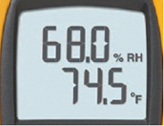
Actions: You think this is too easy. Probably a system-related problem (dirty filter, low charge, dirty condenser; the usual stuff.) But you also realize that it's been a little cooler than most summers. You measure the indoor temperature and relative humidity and find that it is 74.5 degrees F, 68 percent relative humidity (rh), 66 degrees F wet bulb temperature, and 63.3 degrees F dew point.
You are concerned because with a cooler than normal summer, operating times are less (less moisture removal), and carpet over concrete slab can hide moisture problems and create an environment for fungal growth. You wonder if there is a moisture-holding sand layer between the vapor barrier and the slab, which would exacerbate moisture problems under the carpet.

You ask the homeowner if any remodeling changes have occurred to the house. They say, "No. Wait. We had a new roof installed. Does that count?" You ask, "Same composition roof?" They say, "Yes, but we changed the color from dark green to white." You say, "Thanks. I also noticed that you run your fan continuously. Is there a reason for that?" They say, "We think it keeps the air moving and makes it feel more comfortable." You think you'll comment on that later after you have finished gathering data.

You move back indoors. As you climb into the attic to check the air handler (80 AFUE gas furnace), you're thinking about the reduced attic temperature and heat gain from a light colored roof compared to a dark one. This not only will contribute to reduced operating times, but cooler attic temperatures increase the chances of condensation on the supply duct and air handler, especially with a 72 degrees F dew point. The attic is 108 degrees F. Good. Not too cool. You look at the ductwork, furnace, and horizontal evaporator. You scan the foil faced duct wrap with your infrared thermometer. You are relieved to see it is an average of 76 degrees F. Wait. About 6 feet from the air handler your infrared measures 72 degrees F and on closer inspection, it feels damp.

The filter is relatively clean. You replace it and inspect the evaporator. It too is clean, but is not level and water is higher on the backside of the pan than the front where the drain is located. You're in luck. The furnace and evaporator were hung using turnbuckles. You adjust the turnbuckles for best drainage. That will help reduce re-absorption of moisture into the air stream during the off cycle, but you wish the evaporator used a TXV rather than a fixed restrictor metering device because you know a TXV will offer better performance at part load conditions.

Options
Now you are ready to decide what the options are to improve performance at part load conditions.1. First improvement already accomplished by re-leveling condensate pan for better drainage.
2. Advise homeowners to operate fan in "auto" to reduce moisture regain during off cycles.
3. You noticed they got a best quality electronic thermostat that allows adjustment of the differential setting. You decide to change it from a 1 degree F to a 1.5 degree F differential for longer on times resulting in more steady state moisture removal time.

5. Replace fixed restrictor with TXV.
6. Replace ripple edged fin evaporator with straight fins and wider fin spacing because ripple edged fins tend to hold more water, and closer spaced fins hold more water.
Options 1, 2, and 3 are implemented. Since the equipment is not oversized, you think it will result in the desired effect. Option 4 makes you nervous, so you decide if further improvement is needed later, you can try it then. You don't want to bring up options 5 and 6 due to the inevitable cost discussion.

So Now It's Time For Your Presentation To The Homeowner...
"The high humidity you have been experiencing indoors is a result of lower outdoor temperatures that result in less operating time. Less operating time means less moisture removal. Running the fan continuously allows moisture remaining on the evaporator and in the drain pan to be re-absorbed into the air stream and keeps the humidity above comfort levels."I strongly recommend a thermostat ‘Fan Auto' setting for overall comfort. I was able to make an adjustment to the condensate pan for better drainage, which will help. And I've adjusted your thermostat for better moisture control. For increased comfort at night when there is no solar heat gain, I recommend a thermostat setting 1 to 2 degrees lower than during the daytime.
"There are additional things that can be done, but I don't think the expense of these modifications would be cost effective for you at this time. I believe the low cost changes I have made for you will result in the humidity levels you are seeking. If time should prove me wrong, then we can address the other options at that time, but again, I believe you are going to be happy with the adjustments I have made."
Reprinted from the Fluke Application Note "Investigating residential humidity complaints." For more information, visit www.fluke.com.

Report Abusive Comment